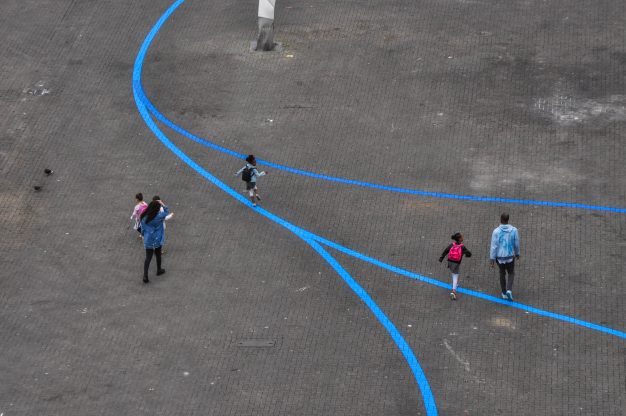
Let’s enrich public space – especially in poor neighbourhoods
Redesigning public space can transform the feel of a neighbourhood, but sometimes the expense, though modest, can inhibit the aspiration of the residents who need it most. Nadine Roos reflects on what may be the true cost of selling deprived areas short in public realm design.
I am in a public square in Rotterdam, early one morning. It is a deprived part of the city. Though late in May, there is still a chill in the air, and the cold grey skies make the place appear even duller than usual.
We are participating in an initiative to make the square more attractive for the local residents. There is great anticipation as the first layer of paint is applied, and I become more and more excited as I watch our design slowly transforming the previous grey and drab façade into something colourful and vibrant.
It’s very beautiful – but expensive, right?
As people pass through the square, some of them, curious, stop to have a closer look at our freshly applied blue lines. Passers-by start to chat with me. Very happy with the result, I am glad to answer their questions. There is a remark, though, that surprises me and keeps me thinking for days. One man says: “It’s very beautiful; but expensive, right?”
Deprived
This is not the first time I have heard such a comment. On a previous project, I encountered a similar reaction. Residents of a similarly deprived part of the city had taken the initiative to create a garden especially for girls. Together with a landscape designer, we were asked to create the design.
At one point, we needed just €4000 for a particular element of the design. For public realm projects this is a very small sum. However, the member of the group responsible for fundraising refused to apply for the money, suggesting that she could not justify such an expense to the poor people living in the area: families for whom €4000 is a huge amount of money.
Such reactions are understandable and sympathetic. Yet, at the same time, they are dangerously toxic, because the corollary of this thinking is that only affluent parts of the city are worth generous budgets. Imagine the result. It would effectively say to residents – and especially the children – of poorer areas, ‘You are not worthy to live in a good, pleasant and healthy environment’.
Environment matters
It is especially important to invest in the public realm in areas where people are struggling. Environment matters, and people living with various hardships and struggles can only be made to feel less hopeful if their surroundings are harsh or dreary.
I have no doubt that most municipal employees and designers hold dear the value of good public space. But how do we make sure that the residents also feel that they are worthy of living in a pleasant place? By having conversations with them, of course; and by continuing to make beautiful designs. I haven’t quite figured it out. This sentiment goes deep and I suspect much more needs to be done.
Happily, we also heard another comment that day, one that made our hearts melt. Later in the afternoon, while we were taking pictures of the square from the top floor of an adjacent flat, we overheard a little girl talking to her dad. Enthusiastically, she said: “Look daddy, from here it looks even more beautiful!” It’s so precious that this little girl knows and feels that beauty is there for her.
Nadine Roos
HUNK-design
Photo: HUNK-design




